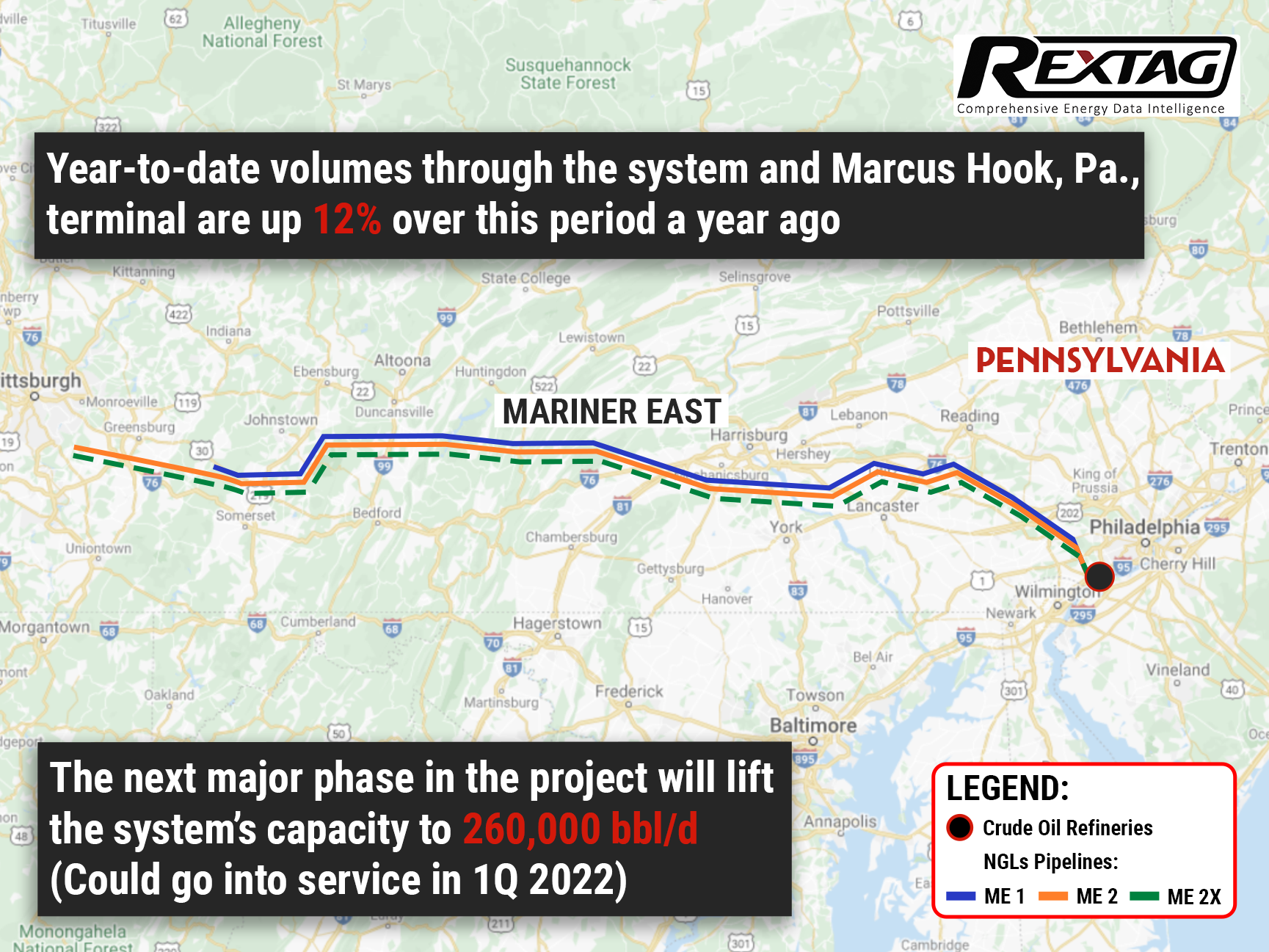Comprehensive Energy Data Intelligence
Information About Energy Companies, Their Assets, Market Deals, Industry Documents and More...
The Final Stretch: Energy Transfer Pushes For Mariner East Project Ahead Of The Stunning Q3 Results
12/08/21
A market share of almost 20%, double that of 18 months ago, was held by Energy Transfer LP in the third quarter, the most of any country or company in the world in NGL exports. The company, however, has a bit of a slip in the results, compared to the strong showing over the same period a year prior.
In 2020, consolidated adjusted EBITDA in the third quarter was $2.9 billion, compared to $2.6 billion this time around. In line with this, discounted cash flow (DCF) is also down to $1.31 billion, from $1.69 billion a year ago.
Energy Transfer also reported earnings of $0.20 per unit and revenues of $16.66 billion, which solidly outperformed expectations from the likes of the Zacks Consensus with their estimate of $14.96 billion.
Tom Long, co-CEO of Energy, noted that the company was able to tie itself over the higher volumes in most segments seamlessly this year due to the one-time gain of $103 million in the midstream segment and the success of the former optimizations. Long also noted that the winter storm of 2021 resulted in higher utility bills and other expenditures.
All of these gains and expenses — the result of Energy Transfer owning and operating one of the largest and most diversified portfolios of energy assets in the United States, with strategic stakes in all major domestic production basins. All of this is in addition to midstream, intrastate, and interstate natural gas transportation and storage assets, oil and petroleum products transportation and terminal assets, NGL fractionation assets, and acquisition and marketing assets.
In the meantime, though, one of the heaviest things on Energy's plate is the Mariner East project with its myriad of challenges. A new phase in the project has been commissioned, which will increase the project's capacity to 260,000 bbl/d. Yet, even with the uncompleted project, the volumes going through the system and the terminal in Marcus Hook, Pa saw a 12% increase compared to the last year.
However, the project is handicapped at the moment. New permit modifications are required for converting the final directional drill to an open cut. Afterward, Mariner East's last segment could be operational by the end of the first half of 2022. But whether or not this timeline will hold to be true is unknown for now.
If you are looking for more information about energy companies, their assets, and energy deals, please, contact our sales office mapping@hartenergy.com, Tel. 619-349-4970 or SCHEDULE A DEMO to learn how Rextag can help you leverage energy data for your business.
Smart Investments Are The Key To Success: Williams JV Brought Benefits At The End Of The Year
![$data['article']['post_image_alt']](https://images2.rextag.com/public/blog/Williams-JV-Brought-Benefits-At-The-End-Of-The-Year.png)
Williams boasts its Q3 results. With a revenue of $2.48 billion, the company beat the analyst estimate of $2.09 billion and also improved upon its own results over the same period in 2020. Mind you, much of this success was attributed to production in Wyoming's Green River Basin's Wamsutter Field and Williams JV with Crowheart.
No More Gas Flaring: the Permian's Double E Pipeline is brought into service in West Texas
![$data['article']['post_image_alt']](https://images2.rextag.com/public/blog/The-Permians-DoubleE-Pipeline-is-brought-into-service-in-West-Texas.png)
Permian Basins gas infrastructure boom: Summit Midstream puts into service a new pipeline system, aimed at reducing gas flaring in the area. Besides ecological concerns, the project will also transport almost 1,5 billion cubic feet of gas per day — enough to supply 5 million U.S. homes every day. According to Federal Energy Statistics, the project cost a whopping $450 million.
![$data['article']['post_image_alt']](https://images2.rextag.com/public/blog/328_Blog_Why Are Oil Giants Backing Away from Green Energy Exxon Mobil, BP, Shell and more .jpg)
As world leaders gather at the COP29 climate summit, a surprising trend is emerging: some of the biggest oil companies are scaling back their renewable energy efforts. Why? The answer is simple—profits. Fossil fuels deliver higher returns than renewables, reshaping priorities across the energy industry.
![$data['article']['post_image_alt']](https://images2.rextag.com/public/blog/327_Blog_Oil Market Outlook A Year of Growth but Slower Than Before.jpg)
The global oil market is full of potential but also fraught with challenges. Demand and production are climbing to impressive levels, yet prices remain surprisingly low. What’s driving these mixed signals, and what role does the U.S. play?
![$data['article']['post_image_alt']](https://images2.rextag.com/public/blog/326_Blog_USA Estimated Annual Rail CO2 Emissions 2035.jpg)
Shell overturned a landmark court order demanding it cut emissions by nearly half. Is this a victory for Big Oil or just a delay in the climate accountability movement?